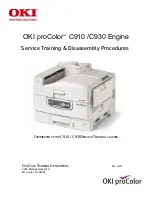
Product Self Tests
PcOS Series 90PLUS
Programmer's Guide
Page 114
Rev Q
11/07/05
7
Product Self Tests
The Series 90PLUS Printer contains several levels of self-test features. At power on, the printer always runs Level 0
diagnostics which check the printer’s operation. After Level 0 diagnostics, the printer checks the keypad and enters
normal operation or extended tests.
7.1
Level 0 Diagnostics
Level 0 diagnostics always run at power up. They perform the following tasks.
Test
Ready Indicator
Form Indicator
Reset
orange
off
CPU Test and ROM Test
orange
green
External RAM Test
red
green
Mechanical Tests
off
green
Table 20 Level 0 diagnostics
If any of these tests fail, the printer faults, and an error is displayed. It is possible that if the first test fails the
orange/green status will remain on the display. If this occurs, the ROM or CPU is defective.
7.2
Extended Diagnostics
Extended diagnostics are entered after Level 0 diagnostics and allow one of four modes to be entered. The four
modes are: self test; hex dump; configuration; and remote configuration. In self-test mode, the various modes of
the printer can be tested. Hex dump mode causes the printer to print the hex value of any print information sent
to the printer. Configuration mode allows various configuration parameters to be adjusted, and remote
configuration mode allows CFG90 to configure the printer.
7.2.1
Self-test Mode
Pressing and holding the RESUME key at power up enters self-test mode. (As soon as the printer starts to
print, the key should be released). The printer will print the software revision information and instructions
for using self-test mode. The FEED key will feed paper. The RELEASE key will select a test, and the
RESUME key will start the test.
There are currently eight tests in the test suite. The tests are described below.
1. The receipt test prints a sample receipt.
2. The validation test performs a sample validation.
3. The slip test performs a sample slip operation.
4. The check test (MICR calibration) prints a sample check test pattern. It tests feed control on narrow test
forms. If the printer has a MICR reader, this test will perform a MICR calibration. MICR calibration
requires a calibration check, which is available from Ithaca Peripherals.
5. The self test checks a number of the printer’s capabilities.
6. The mechanical test mode allows the slip drive and form compensation mechanism to be tested.
The line feed key will operate the slip drive, and the RESUME key will operate the form compensation.
7. The rolling ASCII test allows continuous print on the printer. It tests reliability and ribbon life.
Summary of Contents for Ithaca 90PLUS Series
Page 2: ...Page ii Rev Q 11 07 05...
Page 12: ......
















































